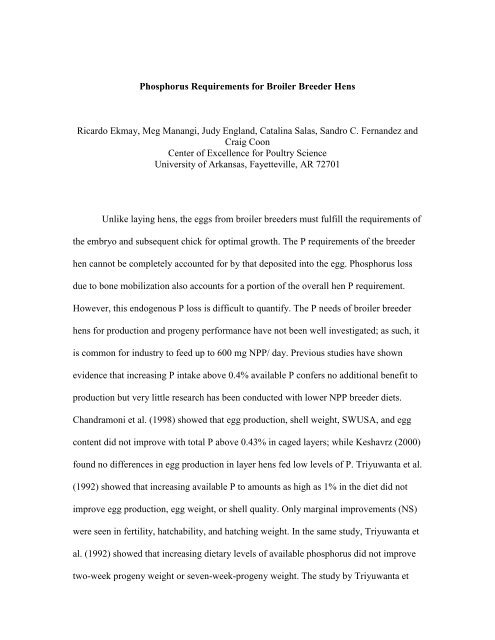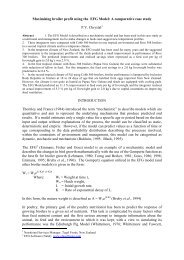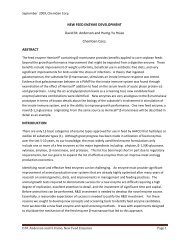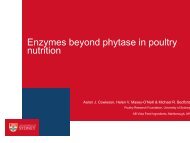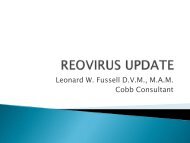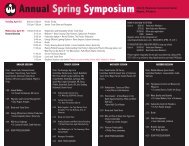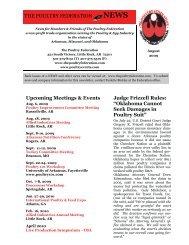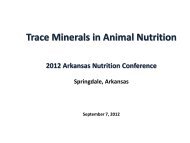Phosphorus Requirements for Broiler Breeder Hens - The Poultry ...
Phosphorus Requirements for Broiler Breeder Hens - The Poultry ...
Phosphorus Requirements for Broiler Breeder Hens - The Poultry ...
You also want an ePaper? Increase the reach of your titles
YUMPU automatically turns print PDFs into web optimized ePapers that Google loves.
<strong>Phosphorus</strong> <strong>Requirements</strong> <strong>for</strong> <strong>Broiler</strong> <strong>Breeder</strong> <strong>Hens</strong>Ricardo Ekmay, Meg Manangi, Judy England, Catalina Salas, Sandro C. Fernandez andCraig CoonCenter of Excellence <strong>for</strong> <strong>Poultry</strong> ScienceUniversity of Arkansas, Fayetteville, AR 72701Unlike laying hens, the eggs from broiler breeders must fulfill the requirements ofthe embryo and subsequent chick <strong>for</strong> optimal growth. <strong>The</strong> P requirements of the breederhen cannot be completely accounted <strong>for</strong> by that deposited into the egg. <strong>Phosphorus</strong> lossdue to bone mobilization also accounts <strong>for</strong> a portion of the overall hen P requirement.However, this endogenous P loss is difficult to quantify. <strong>The</strong> P needs of broiler breederhens <strong>for</strong> production and progeny per<strong>for</strong>mance have not been well investigated; as such, itis common <strong>for</strong> industry to feed up to 600 mg NPP/ day. Previous studies have shownevidence that increasing P intake above 0.4% available P confers no additional benefit toproduction but very little research has been conducted with lower NPP breeder diets.Chandramoni et al. (1998) showed that egg production, shell weight, SWUSA, and eggcontent did not improve with total P above 0.43% in caged layers; while Keshavrz (2000)found no differences in egg production in layer hens fed low levels of P. Triyuwanta et al.(1992) showed that increasing available P to amounts as high as 1% in the diet did notimprove egg production, egg weight, or shell quality. Only marginal improvements (NS)were seen in fertility, hatchability, and hatching weight. In the same study, Triyuwanta etal. (1992) showed that increasing dietary levels of available phosphorus did not improvetwo-week progeny weight or seven-week-progeny weight. <strong>The</strong> study by Triyuwanta et
al.(1992) shows the current practice of feeding 600 mg NPP/day to breeders may not benecessary but additional research is needed to show how much NPP is needed to maintainoptimum per<strong>for</strong>mance <strong>for</strong> the breeder and her progeny. Plumstead and Brake (2007)conducted three floor pen feeding studies with breeders housed on slats to determine theavailable P requirement while feeding corn/ soybean/ phytase diets. <strong>The</strong> researchers fedcorn soy diets and added 0.10% available P from phytase to the breeders and suggested316 mg available P was needed <strong>for</strong> egg production. <strong>The</strong> researchers suggested additionalavailable P (0.32% available P) was needed <strong>for</strong> maximum fertility if pullets were rearedfrom 10wk of age on only a corn /soybean and phytase diet.A large amount of research has been previously conducted with commerciallayers showing optimum levels of calcium and calcium particle solubility needed <strong>for</strong>optimum per<strong>for</strong>mance and eggshell quality. Common (1932, 1933, and 1936) workingwith laying hens reported a rise in excreta P corresponding to the period of shell<strong>for</strong>mation, and attributed the excess phosphorus to phosphate set free when the calciumwas removed from the bone <strong>for</strong> shell <strong>for</strong>mation. Research has already shown that feedingcommercial layers large particle size calcium improves both the eggshell quality and thebone ash during lay. Commercial layers are fed free choice whereas broiler breeders arecontrol fed a restricted amount of feed throughout the rearing and production period andare generally fed one time early in the morning. <strong>Breeder</strong>s are generally not fed largelimestone particles <strong>for</strong> several reasons. It is thought that breeder hens do not produce asmany eggs as commercial layers and thus the large particle limestone would not be ascritical during a production period. <strong>Breeder</strong> feed may be fed as pellets by someintegrators, which would require smaller calcium particles. <strong>Broiler</strong> integrators may also
use one feed mill <strong>for</strong> producing both broiler and broiler breeder feed, which may limitusing extra bin space <strong>for</strong> the different calcium feedstuffs. <strong>The</strong> feeding of large Caparticles may result in slow release of Ca since larger limestone particles remain longer inthe gizzard, leading to availability of Ca <strong>for</strong> intestinal absorption during the period ofshell <strong>for</strong>mation. Due to the continuous availability of Ca <strong>for</strong> gut absorption by feedinglarger particle size limestone (calcium source), there may be a reduction in the bonemobilization of Ca along with its counter ion P, especially during shell calcification,thereby reducing P excretion. Coon and Leske (1999) reported that commercial layers fedincreasing levels of NPP along with large particle size limestone compared to smallparticle limestone excrete less total phosphorus per g P consumed. When marine shellswere fed to broiler breeder hens and compared to ground limestone it was found thatmarine shells improved egg weight, 1-day progeny weight, yield stress and elasticde<strong>for</strong>mation of tibiae from 1-day old progeny (Guinotte and Nys, 1990). Feeding largerparticle size limestone has been shown to increase the retention of limestone particles <strong>for</strong>a longer time period in the gizzard (Zhang and Coon, 1997) and increased the overallcalcium retention <strong>for</strong> layers by improving calcium deposition in eggs.<strong>The</strong> effects of reduced NPP levels and limestone particle size on broiler breederproduction, skeletal integrity, progeny quality, and P balance.Three experiments were conducted to investigate the impact of lowered NPPintake and changes in limestone particle size on production per<strong>for</strong>mance, progenyper<strong>for</strong>mance, and phosphorus retention <strong>for</strong> broiler breeders (Ekmay and Coon, 2008). Inthe first experiment, 700 Cobb 500 breeders were reared according to Cobb guidelines
(Cobb-Vantress, 2005) and transferred to a production house at 147 days. At 168 days,285 birds were switched over to one of five experimental diets (5 groups of 57 breederhens) that differed only in the level of NPP. <strong>Phosphorus</strong> levels ranged from 0.2% to 0.4%NPP in 0.05% increments; and corresponded to a daily intake of 288, 360, 432, 504 and576 mg NPP with 144g feed at peak. <strong>The</strong> breeders were fed 3.25% Ca primarily fromlarge particle limestone(X 50 = 3489.73µm). Production per<strong>for</strong>mance, egg quality, breederand progeny skeletal quality, hatchability, progeny weight, and P retention weremonitored throughout the experimental period. Results show that total egg production,egg number, age at sexual maturity, and egg weight were not negatively affected bylowering NPP levels to 0.20% in the breeder diet (Table 1). Shell quality, thoughstatistically impacted by NPP level, remained at high levels <strong>for</strong> all treatments (above1.081). Reproductively, reduced dietary NPP did not negatively impact hatchability orsubsequent progeny per<strong>for</strong>mance. Day old and three-week progeny weights werecomparable as was progeny bone quality (Table 2). <strong>Breeder</strong> tibia ash and relative strengthwas impaired at 0.20% NPP. <strong>Breeder</strong>s fed low levels of dietary NPP had lower total Pexcretion and greater overall P retention (Table 3). <strong>The</strong> amount of P deposited into theegg was not different among the treatment groups.In the second experiment, ninety-four 21 week-old broiler breeder hens were feddiets that consisted of the same five NPP levels as in the first experiment and one of twolimestone particle sizes (large particle:X 50 = 3489.73µm and small particle: X 50 =185.50µm). <strong>The</strong> breeders were peaked on 144g of feed. Production per<strong>for</strong>mance, eggquality, breeder skeletal quality, and P retention were monitored throughout theexperimental period. No differences were seen in egg production, age at sexual maturity,
specific gravity or tibia relative strength due to NPP intake. However, increasing dietaryNPP led to the production of heavier eggs. Increasing dietary NPP also increased total Pexcretion but did not show an effect on overall Ca or P retention possibly being partiallyexplained by increased bone ash in breeders fed larger intakes of NPP (Table 4). <strong>Breeder</strong>sfed large particle limestone, independent of dietary NPP intake, showed a tendency toreduce the amount of total P excreted (p=0.08). A rise in the amount of P deposited intothe egg by hens fed large particle limestone may also partially account <strong>for</strong> these results.Feeding large particle limestone also improved shell quality and tibia relative strength.Results appear to indicate that lower levels of NPP intake do not impair a breeder hen’sper<strong>for</strong>mance or progeny per<strong>for</strong>mance and that feeding large particle limestone mayimprove several aspects of a breeder hen’s per<strong>for</strong>mance. <strong>Hens</strong> are able to maintain theirper<strong>for</strong>mance by mobilizing bone reserves to meet the demands of egg <strong>for</strong>mation andutilize dietary sources to replenish these reserves.In the third experiment, Cobb 500 breeder pullets were reared to three differentgrowth curves (20% under, Cobb standard, 20% over) and followed Cobb guidelines <strong>for</strong>all other rearing parameters. At 21 wks, 648 breeders were transferred to a productionhouse and individually fed one of two experimental diets (12 groups of 54 birds) thatdiffered in the level of NPP; the other treatment groups included pullet rearing andfeeding regimen <strong>for</strong> a 3x2x2 factorial study. <strong>Phosphorus</strong> levels were 0.15% or 0.4%NPP;and corresponded to a daily intake of 216 and 576 mg NPP at peak with 144g feedconsumed, respectively. <strong>The</strong> breeders were fed 3.25% Ca with a 50% mix of largeparticle (X 50 = 3159.41 µm) and small particle (X 50 =192.89 µm) limestone. Feedingregimens consisted of a normal and an altered regimen. <strong>The</strong> normal regimen consisted of
feed adjustments appropriate <strong>for</strong> the treatment group’s per<strong>for</strong>mance. <strong>The</strong> altered regimenconsisted of feed adjustments appropriate <strong>for</strong> the flock as a whole. Productionper<strong>for</strong>mance, egg quality, breeder skeletal quality, and P retention were monitoredthroughout the experimental period. Plasma samples were collected and assayed <strong>for</strong>PTHrp, tartrate-resistant acid phosphatase (TRAP), and total alkaline phosphatase (totalALP) using colorimetric assays (Lau et al., 1987), and plasma P utilizing a modifiedmethod of the procedure described by Daly and Ertingshausen (1971). Eggs per henhoused were diminished in hens fed the low dietary NPP, and by low pullet target weight(Table 5). <strong>Hens</strong> fed low dietary NPP also had lower egg weights but better shell quality.Mortality was significantly higher in hens fed low dietary NPP and pullets with low BWwere specifically affected, especially during weeks 26-28. <strong>Breeder</strong> tibia relative strengthand ash was also significantly lower in hens fed low dietary NPP %, regardless of thequantitative amount. Hatch of fertile was not impacted by NPP intake or by rearingprogram, but was affected by breeder feeding regimen (p=0.0031). Progeny bone qualitywas not significantly affected by any treatment. However, an initial benefit in 1 dayprogeny weight was observed <strong>for</strong> hens fed 0.4% NPP. Circulating blood PTHrp washigher at 24 weeks of age than at 29 weeks of age (peak) and PTHrp levels were lower inhens reared 20% over target BW (Table 6). Osteoclast activity (TRAP; Figures 1 and 2)and bone mobilization appears to peak 8-12 hours post feeding; followed by a period ofbone re-deposition (total ALP; Figures 1 and 2). Deficiencies in dietary NPP do notappear to exert an effect until nearing peak production; pullet rearing appears to exert agreater effect during the transition into sexual maturity. <strong>Hens</strong> on 0.15% NPP willmobilize less bone than hens on 0.40% NPP, even at peak production. Plasma P readings
support these conclusions (Figure 3) showing breeders fed 0.14% NPP had less reactiveP in plasma. <strong>Hens</strong> reared on a 20% under growth curve had reduced egg production.“Under” hens had higher levels of bone deposition (total ALP; Table 8) at 24 and 26weeks, and lower levels of bone resorption (TRAP; Table 7) at 24 weeks. In summary,0.15% dietary NPP and the 20% under pullet growth curve negatively impact eggproduction as well as breeder skeletal integrity, but do not impair progeny skeletalintegrity. Body composition appears to be a main contributor in bone remodelingmechanisms.Ca particle size effect on broiler breeder egg shell quality, bone ash and P excretionA six-week experiment was conducted to evaluate the effects of two different Ca particlesizes on a) Ca and P retention and percent tibia ash in normal broiler breeder hens, and b)total urinary Ca and P excretion in colostomized broiler breeder hens (Manangi et al.,2007). Three hundred broiler breeder pullets (Cobb 700), 23 wk of age, were offered acorn-soybean meal breeder diet (based on NRC, 1994 recommendation) in individualcages until 30 wk of age. Some of the broiler breeder hens, 25-30 wk of age, withuni<strong>for</strong>m body weights were used <strong>for</strong> colostomy. During the 31 st week, 150 hens weredivided into two groups of 75 each and offered the test diets. <strong>The</strong> colostomized birdswere also divided into two groups (3 birds per treatment) and offered diets similar tonormal birds. <strong>The</strong> calcium added to the basal diets consisted of two different particlesizes of limestone. <strong>The</strong> smaller particle size limestone passed a 300 microns mesh screen(X 50 = 185.50 µm) whereas the larger particle size limestone passed a 4.57 mm meshscreen (X 50 = 3527.33µm). <strong>The</strong> nutrient retention study consisted of feeding ten broiler
eeders from each non-colostomized group and ten colostomized breeders theexperimental diets with added acid insoluble ash (Celite). Data from this experiment weresubjected to “two group t- test” to determine the statistical significance (SAS Institute,1999).Although the P excretion difference was not significant (P=0.15) during the six weekbreeder study, a numerical improvement of 2.09 percentage points P retention and 3.69percentage points Ca retention was obtained <strong>for</strong> non-colostomized breeders fed largersize limestone particles compared to non-colostomized breeders fed smaller particle sizelimestone (Table 9). <strong>The</strong>re was a significant (P < 0.0001) improvement of 3.22percentage points in tibia ash content in the group fed larger particle size limestonecompared to hens fed smaller particle size limestone <strong>for</strong> a 6 wk (Table 9) period. Averagehen day egg production <strong>for</strong> a period of 6 wk showed no difference (P > 0.05) between thetwo groups of broiler breeder hens fed two different particle sizes of limestone (Table 9).For the non-colostomized birds, feeding a larger particle size of limestone significantly (P< 0.05) increased the specific gravity of eggs as compared to smaller particle sizelimestone fed group (Table 9). A numerical improvement of 0.12 percentage points in %dry shell weight and 0.59 mg/cm 2 in shell weight per unit surface area (SWUSA) wereobtained <strong>for</strong> non-colostomized breeders fed larger size limestone particles compared tonon-colostomized breeders fed smaller particle size limestone (Table 9). <strong>The</strong> diurnalpatterns of total urinary Ca and P excretion by broiler breeder hens are shown in theFigure 12. <strong>The</strong> total P excretion was low during 0-11 h, and 20-24 h post oviposition,whereas the P excretion was at its maximum during 11-20 h post oviposition. <strong>The</strong> total
Cheng, TK and Coon, CN. 1990a. Effect of calcium source, particle size, limestonesolubility In vitro, and calcium intake level on layer bone status and per<strong>for</strong>mance. Poult.Sci. 69: 2214-2219.Cheng, TK and Coon, CN. 1990b. Effect on layer per<strong>for</strong>mance and shell quality ofswitching limestones with different solubilities. Poult. Sci. 69; 2199-2203.Common, R.H. 1932. Mineral balance studies on poultry. J. Agr. Sci. 22:576.Common, R.H. 1933. Observations on the mineral metabolism of pullets. J. Agr. Sci.23:555.Common, R.H. 1936. Observations on the mineral metabolism of pullets. II. J. Agr. Sci.26:85.Farmer, MD, Roland, DA Sr., and Clark, AJ. 1986. Influence of dietary calcium on bonecalcium utilization. Poult Sci. 65; 337-344.Fleming, RH, Whitehead, CC, Alvey, D, Gregory, NG, and Wilkins, LJ. 1994. Bonestructure and breaking strength in laying hens housed in different husbandry systems. Br.Poult. Sci. 35: 651-662.Guinotte, F and Nys, Y. 1991. <strong>The</strong> effects of a particulate calcium source in broilerbreeder hens upon their egg quality, reproductive traits, bone reserves, chick weight andtibia strength characteristics. Arch. Geflügelk. 55(4); 170-175.
Guinotte, F. 1987. Efficacité de différentes sources de calcium pour l'ossification dupoulet et la qualité de la coquille de l'oeuf. Rôle de la sécrétion acide dans leur utilizationdigestive. Rapport Bibliographique, Station de Recherches Avicoles, INRA Tours-Nouzilly, 1-56.Keshavarz, K. 2000. Nonphytate phosphorus requirement of laying hens with and withoutphytase on a phase feeding program. Poult. Sci. 79: 748-763.Klasing, KC. Comparative Avian Nutrition. CAB International. 1998. pp. 238-252Kornegay, ET, Denbow, DM, Yi, Z, and Ravindran, V. 1996. Response of broilers tograded levels of microbial phytase added to maize-soyabean meal based diets containingthree levels of non-phytate phosphorus. Br. J. Nutr. 75: 839-852.Leske KL and Coon, CN. 1999. A bioassay to determine the effect of phytase on phytatephosphorus hydrolysis and total phosphorus retention of feed ingredients as determinedwith broilers and laying hens. Poult. Sci. 78; 1151-1157.Li, H, Berry, WD, Hess, JJB, Lien, RJ, Roland, DA and Oates, S. 2002. Phytasesupplementation <strong>for</strong> rearing and production of heavy strain broiler breeders. Poult. Sci.80 (suppl. 1): 4. (abstr.)
McDaniel, G. R., J. Brake and M. K. Eckman, 1981, "Factors Affecting <strong>Broiler</strong> <strong>Breeder</strong>Per<strong>for</strong>mance. 4. <strong>The</strong> Interrelationship of Some Reproductive Traits," <strong>Poultry</strong> Science60:1792-1797.Miles, RD. 1980. <strong>The</strong> role of phosphorus in egg shell quality. Proc. Florida Nutr. Conf.,Florida, U.S., 95-110Nys, Y and Triyuwanta. 1991. Relationship between egg quality of dwarf breeder hensand growth and bone ossification of the offspring. Proceedings of the 4th EuropeanSymposium on the Quality of Eggs and Egg Products. pp. 159-167.Plumstead, PW, Romero-Sanchez, H, Maguire, RO, Gernat, AG and Brake, J. 2007.Effects of phosphorus level and phytase in broiler breeder rearing and laying diets on liveper<strong>for</strong>mance and phosphorus excretion. 86; 225-231.Rath, NC, Huff, WE, Huff, GR, and Balog, JM. 1998. Bone biodynamics of five to fiftyfiveweek-old male broiler breeder chickens. Proceedings of the Arkansas NutritionConference. Fayetteville, Arkansas. pp.40-52.Rennie, JS, Fleming, RH, McCormack, HA, McCordquodale, and Whitehead, CC. 1997.Studies on effects of nutritional factors on bone structure and osteoporosis in laying hens.Br. Poult. Sci. 43:127-134.
Roland, DA Sr. 1986. Eggshell quality IV. Oyster shell versus limestone and theimportance of particle size or solubility of calcium source. World's Poult. Sci. 42; 166-171.Triyuwanta, Leterrier, C and Nys, Y. 1992. Dietary phosphorus and food allowance ofdwarf breeders affect reproductive per<strong>for</strong>mance of hens bone development of theirprogeny. Br. Poult Sci. 33; 363-379.Viveros, A, Brenes, A, Arija, I, and Centeno, C. 2002. Effects of microbial phytasesupplementation on mineral utilization and serum enzyme activities in broiler chicks feddifferent levels of phosphorus. Poult. Sci. 81: 1172-1183.Whitehead, CC. 2004. Overview of bone biology in the egg-laying hen. Poult. Sci. 83;193-199.Zhang, B and Coon, CN. 1994. <strong>The</strong> effect of feeding various calcium particle sizes,solubilities and quantities <strong>for</strong>m the early stages of lay on bone status and eggshell qualityof the first laying cycle. Master thesis. University of Minnesota, Minnesota.Zhang, BF and Coon, CN. 1994a. Egg shell quality and bone status as affected byenvironmental temperature, calcium and phosphorus intake, and limestone solubility inlaying hens. Master thesis. University of Minnesota.
Zhang, BF and Coon, CN. 1994b. <strong>The</strong> relationships and indications of various boneparameters in hens. Master thesis. University of Minnesota.Table 1. <strong>Broiler</strong> breeder per<strong>for</strong>mance of hens fed graded levels of NPP through 65 wks.
Table 2. Progeny quality of broiler breeders fed graded levels of NPP through 65 wks(Experiment 1).
Table 3. P balance of broiler breeders fed graded levels of NPP at 52 wks of age fed a130 g meal (Experiment 1).
Limestoneparticle sizeDietary NPP%Total Feed P(mg)Total ExcretaP (mg)Total Pretention (%)Total Egg P(mg)Total Egg P(ppm)Total FeedCa (g)Total ExcretaCa (g)Total Caretention (%)Large 763.72 538.86 ± 19.60 28.40 ± 2.48 131.42 ± 5.98 7931.67 ± 55.89 4.62 3.36 ± 0.28 27.25 ± 6.02Small 763.72 589.63 ± 21.54 22.81 ± 2.72 109.25 ± 6.63 7248.88 ± 58.43 4.62 3.19 ± 0.31 30.96 ± 6.61p values0.20% 605.49 479.63 ± 30.29 20.79 ± 3.83 115.66 ± 9.49 7485.22 ± 85.22 4.62 2.32 ± 0.43 49.65 ± 9.300.25% 653.20 504.96 ± 35.19 22.69 ± 4.45 130.99 ± 10.73 7758.99 ± 90.63 4.62 2.94 ± 0.50 36.20 ± 10.800.30% 789.17 549.73 ± 35.19 30.34 ± 4.45 114.50 ± 10.73 7652.36 ± 98.30 4.62 3.81 ± 0.50 17.38 ± 10.800.35% 799.32 606.78± 30.05 24.09 ± 3.80 124.31 ± 9.17 7683.16 ± 87.67 4.62 3.64 ± 0.43 21.12 ± 9.220.40% 971.42 680.13 ± 31.68 30.12 ± 4.00 116.20 ± 9.66 7371.42 ± 89.62 4.62 3.64 ± 0.45 21.19 ± 9.72Particle size NA 0.0863 0.1339 0.0276
DietaryNPPPullettrt Feeding regimen EHHEggweight(g)SpecificgravityMortality(%)45-week<strong>Breeder</strong> tibiaash (%)0.15 88.3 52.77 1.0815 19.79 44.860.4 96.9 53.77 1.0809 6.52 50.15Over 99.7 53.3 1.0810 11.64 47.04Standard 92.2 53.27 1.0810 13.44 47.91Under 86 53.24 1.0817 14.4 47.57Alternate 92 53.4 1.0811 14.25 47.38Normal 93.2 53.14 1.0813 12.07 47.64NPP 0.0001
Week 24 Week 29Dietary NPP Pullet rearing Feeding Regimen PTH (ng/ml) PTH (ng/ml)0.15 0.259 0.19280.4 0.2698 0.1888Over 0.2423 0.189Standard 0.284 0.1941Under 0.2669 0.1893Alternate 0.2635 0.2Normal 0.2652 0.1816NPP 0.4454 0.6639Pullet 0.0551 0.8813Feeding 0.9048 0.0501NPP*Pullet 0.3163 0.5489NPP*Feeding 0.0506 0.5237Pullet*Feeding 0.7588 0.3858NPP*Pullet*Feeding 0.4071 0.4929Table 6. Weekly mean values of PTHrp in broiler breeder hens fed different dietary NPPintakes, different pullet rearing and feeding regimen (Experiment 3)
DietaryNPPWeek 24 Week 26 Week 29Pulletrearing Feeding Regimen TRAP (U) TRAP (U) TRAP (U)0.15 929.28 695.97 596.560.4 806.12 843.17 922.6Over 1103.87 917.11 748.47Standard 852.77 638.94 767.78Under 646.48 752.64 762. 49Alternate 1034.32 896.53 843.16Normal 701.08 642.6 675.99NPP 0.2928 0.203 0.0012Pullet 0.0067 0.1463 0.9866Feeding 0.0046 0.0284 0.0942NPP*Pullet 0.351 0.2175 0.0277NPP*Feeding 0.4137 0.9895 0.4794Pullet*Feeding 0.8893 0.5034 0.404NPP*Pullet*Feeding 0.5472 0.9466 0.4298Table 7. Weekly mean values of plasma total TRAP (bone re-sorption) in broiler breederhens fed different dietary NPP intakes, different pullet rearing and feeding regimen(Experiment 3).
Week 24 Week 26 Week 29Dietrary NPP Pullet rearing Feeding regimen total ALP (U) total ALP (U) total ALP (U)0.15 3821.47 1655.51 2216.20.40 3670.35 1732.21 1952.45Over 3489.91 1469.51 2002.81Standard 3413.38 1632.63 1970.28Under 4334.44 1979.44 2279.88Alternate 3846.34 1765.8 2206.28Normal 3645.47 1621.93 1962.38NPP 0.2977 0.4563 0.0221Pullet
Figure 2. Fluctuation of PTHrp, tALP, and TRAP over 24 h in broiler breeders fed 0.15%NPP at 29 wks of age (Experiment 3).
P=0.103P=0.10P=0.15Figure 3. Plasma P concentrations of broiler breeders fed two different levels of dietaryNPP and at two different ages (Experiment 3).
Urinary tP and tCa/24hrs, mg---------After 6 wks------S SSB P > tMean SE Mean SEExcreta P, mg/g DM 18.55 0.87 16.72 0.93 0.1585Excreta Phytate P, mg/g 3.23 0.35 3.04 0.47 0.7533DMExcreta NPP, mg/g DM 15.32 0.90 14.69 1.20 0.6766Total P retention, % 31.00 3.30 33.09 3.72 0.6777Phytate P disappearance, 60.78 4.30 61.32 5.95 0.9422%Ca retention, % 49.86 3.26 53.55 4.15 0.4883Bone (Tibia) Ash, % 54.75 0.50 57.97 0.57


